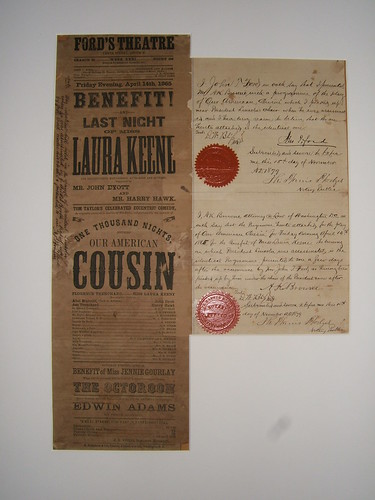Today is not only tax day, but also the 145 anniversary of the death of Abraham Lincoln. Lincoln was shot on April 14, 1865 while attending a performance of Our American Cousin, lingered through the night without regaining consciousness, and died at 7:22 A.M. on April 15, 1865.
One of the items in our current Friend or Faux exhibition is a Ford’s Theatre playbill, accompanied by a sworn and notarized affidavit from John Ford (the theater owner) himself, claiming that he picked up this program was near the President’s chair and gave it to it to A. K. Brownell.  Ford’s Theatre Playbill. [Washington: 1865] A 865f
Ford’s Theatre Playbill. [Washington: 1865] A 865f
It’s a nice story, but one that can’t be true. This playbill was not printed until after Lincoln’s death. It is an example of a so-called “Buckingham reprint” made shortly after Lincoln’s death on the same press and using the same fonts as the genuine pre-assassination playbill. It can be distinguished from a genuine playbill by the marred printed along the right edge (check out the E in Keene) as well as some textual changes.
The definitive survey of Ford’s Theatre playbills is The Ford Theatre Lincoln Assassination Play-bills : A Study which was written by Walter C. Brenner and published in 1937. Our copy of the playbill is actually referenced in this work, although, of course, at the time it was privately owned by Dr. Rosenbach. It turns out that there are two authentic variants of the actual Ford’s Theatre playbill for the fateful night. The Buckingham version imitates the first variant, but after word arrived that Lincoln would attend that night’s performance a second authentic playbill was printed up, which included a patriotic song to be sung at the end of the second act. You can see an example of this variant that was auctioned off at Sotheby’s; the Sotheby’s copy is also accompanied by a family legend of having come from next to chair of President Lincoln. After Lincoln’s death there were a plethora of Ford’s Theater imitations; Buckingham’s was one, another was printed by L. Brown and added a line stating that “THIS EVENING | The Performance will be honored by the presence of | PRESIDENT LINCOLN” version was created that included a patriotic song to be sung at the conclusion of the second act.
Of course there is much more faux Lincoln floating around out there than just the playbills. One of the most famous forgers in history was a man named Joseph Cosey, who created numerous Lincoln manuscript forgeries in the 1930s along with forgeries of Franklin, Mary Baker Eddy, Poe and others. Check out the full story in this fun New Yorker article. We don’t have any Cosey Lincoln forgeries, but we do have a forged Poe manuscript by Cosey, which was in Friend or Faux until the gallery rotation in March. Another Lincoln scam of the 20s and 30s was perpetrated by Eugene Field II and Harry Dayton Sickles. PBS’s History Detectives did a segment on this scam, which enlisted Lincoln’s aged coachman as an unsuspecting dupe. None of this helps me figure out why John Ford notarized our faux playbill. Was he knowingly lying? Was he genuinely confused about the playbill–after all the affidavit was sworn in 1879, 14 years after the fact. Why were the notarized statements taken? So far, I don’t have any answers. Come by Friend or Faux, take a look for yourself, and draw your own conclusions.
